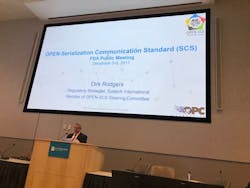As the pharmaceutical industry prepares for 2023—the year the Drug Supply Chain Security Act (DSCSA) will be fully enforced, industry representatives recently gathered with U.S. Food & Drug Administration (FDA) officials to work through some of the obvious obstacles. First and foremost: The need for supply chain interoperability through the implementation of standards.
During the December 2017 DSCSA public meeting, Donald Ashley, the FDA’s director of the office of compliance in the Center for Drug Evaluation and Research (CDER), noted the need to “tighten the system to minimize or eliminate vulnerabilities that facilitate breaches, and in turn, better protect patients from illegitimate drugs that can cause potential harm.” This can be done via electronic tracing of products at the package level, he said.
How to create a closed-loop supply chain system was the crux of the conversation during the two-day meeting—the general conclusion being that this is achievable if the industry unites on how electronic interoperability happens, on standards for data exchange and on the data architecture and methods for data aggregation.
During the meeting, presentations were made by members of the Open Serialization Communication Standard (OPEN-SCS) Group, an initiative under the Open Platform Communications (OPC) industry consortium, as well as the GS1 US standards group. The two organizations, together with the International Society of Automation (ISA) and the International Society for Pharmaceutical Engineering (ISPE), are collaborating to solve track and trace of serialization from the packaging line to the supply chain.
Speaking on behalf of OPEN-SCS, Dirk Rodgers, a member of the group’s steering committee and a regulatory strategist at Systech International, emphasized that, by 2023—the deadline for full supply chain aggregation—the quality of DSCSA transaction documentation exchanged by trading partners will only be as good as the quality of serialization data established during initial packaging operations. “Today’s packaging solutions are not standardized and have no security built-in, leaving them susceptible to incompatibilities, inaccuracies, data loss and theft,” he said. “They have no common name space from line to supply chain, and no common data structure for data exchanges, so the interfaces between solution layers become fragile, threatening data integrity.”
OPEN-SCS is working on an open architecture for packaging lines, called the Packaging Serialization Specification (PSS), that can apply standardization and security in the plant, and accommodate four use cases including serial number provisioning, unused serial number return, product and packaging order master data, and serialization event reporting.
PSS 1.0, done in collaboration with ISPE and GS1 standards, was approved in September of 2017 and is currently being tested by one end user—Pfizer—and nine vendors. PSS 2.0, to be released later this year, will address nine exchange use cases between Level 2 (site serialization manager) and Level 2 (line serialization controllers and smart devices). It will include mapping of data from line level to the enterprise using one name space.
As Automation World reported in the article Strengthening the Supply Chain, OPEN-SCS is also working on what it calls the global Name Space Registry, which will be an open source registry enabling users to meet the reporting requirements of different countries. For example, a large pharmaceutical company with operations in different countries would not have to worry about data mapping, rather, they could just apply the Name Space Registry and the certified interface.
Rodgers said that OPEN-SCS will be critical to the success of industry compliance of the DSCSA because it will ensure standardization, accuracy and security of the product serialization data that is the foundation of the 2023 requirements.
In addition to Rodgers’ presentation, Peter Sturtevant, senior director of pharmaceutical engagement for GS1 US, offered an overview of the organization’s supply chain standards that will also aid in the DSCSA effort. Specifically, the Electronic Product Code Information Services (EPCIS) standard, which provides a common language for describing physical objects, processes and environments, will enable supply chain trading partners to capture information about events (commissioned, serialized, packed, shipped, received, etc.), to answer the what, when, where and why of a product within the chain of ownership—which is a critical component of DSCSA.
Sturtevant said a guideline for using EPCIS for DSCSA was released last year to help companies with identifying, capturing and sharing information. He also emphasized the need for the Core Business Vocabulary, a companion standard to EPCIS critical for interoperability as it is the “dictionary” for trading information electronically.
On the second day of the FDA meeting, Adriano Fusco, marketing director for OPEN-SCS and director of strategy and development at Antares Vision, addressed the challenges of implementing aggregation on production lines and distribution centers, and provided an overview of the solutions commonly adopted for bottles and cartons on fully automated, semi-automated, and manual packaging lines where aggregation is performed by operators with specially designed machines. He also presented an overview of the operations of the largest distribution center in Turkey, which has been working in full aggregation mode since 2012 to comply with its own national mandate.
“Aggregation in packing lines and distribution is very challenging,” Fusco said, noting complex systems have the potential to impact operations. For that reason, Fusco stressed the importance of viewing aggregation as an opportunity to review current lines and operations, and consider modernization.
The conversation will continue during the next public meeting to be held later this month (February 28, 2018) where security needs and building capacity for a unit-level system will be discussed.
A webcast of the December meeting is available on the FDA website: https://www.fda.gov/Drugs/NewsEvents/ucm559090.htm
Leaders relevant to this article:

